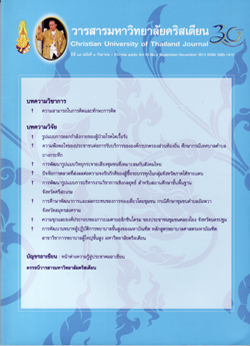การศึกษาพัฒนาการและผลกระทบของการท่องเที่ยวโดยชุมชน กรณีศึกษาชุมชนตำบลอัมพวา จังหวัดสมุทรสงคราม
บทคัดย่อ
อัมพวาเป็นชุมชนตลาดน้ำขนาดใหญ่ ที่มีอายุราวพุทธศตวรรษที่ 18 อยู่ห่างจากกรุงเทพฯ ราว 80 กิโลเมตร ชุมชนอัมพวาเริ่มเป็นที่รู้จักของนักท่องเที่ยว ในปี พ.ศ.2547 และกลายเป็นสถานที่ยอดนิยมในช่วงสุดสัปดาห์ของนักท่องเที่ยวจากหลากหลายพื้นที่ ไม่ว่าทั้งคนไทยหรือแม้กระทั่งชาวต่างชาติ ชุมชนอัมพวาถือว่าเป็นต้นแบบของการอยู่อาศัยเป็นชุมชนไทยดั้งเดิมที่สามารถถ่ายทอดจากรุ่นสู่รุ่น ตั้งแต่อดีตจนถึงปัจจุบัน ไม่ว่าจะเป็นด้านการพานิชย์ การศึกษา สังคม ตลอดจนวัฒนธรรม ประเพณี ที่ยังคงรูปแบบเดิมไว้ได้อย่างเหนียวแน่น นอกจากนี้ยังถือเป็นรูปแบบของชุมชนริมน้ำที่แสดงออกถึงการใช้ชีวิตริมน้ำ การใช้ที่ดิน และการใช้ชีวิตร่วมกับธรรมชาติได้อย่างลงตัว ซึ่งยากที่จะพบเห็นได้ในสังคมปัจจุบัน ด้วยเหตุนี้เอง ทำให้ชุมชนอัมพวาได้รับความสนใจจากนักท่องเที่ยวเป็นอย่างมาก ทั้งเข้ามาศึกษาและท่องเที่ยว จนกลายเป็นจุดเริ่มต้นของการเกิดปัญหาต่างๆ ไม่ว่าจะเป็นขยะมูลฝอย ปัญหารถติด ปัญหาราคาสินค้าที่เพิ่มสูงขึ้น ในขณะที่คุณภาพของสินค้าลดลง อีกทั้งการเป็นจุดเริ่มต้นของการเสื่อมถอยของทรัพยากรทางการท่องเที่ยวต่างๆ รวมถึงสังคม วัฒนธรรมและประเพณีอีกด้วย คณะผู้วิจัยจึงได้ทำการศึกษาถึงพัฒนาการของชุมชนอัมพวาตั้งแต่อดีตจนถึงปัจจุบัน และยังได้รวมไปถึงการศึกษาปัญหาที่เกิดขึ้นของการท่องเที่ยวโดยชุมชนของชุมชนอัมพวา พร้อมทั้งได้เสนอข้อแนะนำ สำหรับให้ผู้อานได้เกิดความเข้าใจเกี่ยวกับการท่องเที่ยวชุมชนอัมพวามากยิ่งขึ้น
เอกสารอ้างอิง
Amphawa District. (1997). Opening ceremony of Amphawa District Building. Samutsongkhram.
Angsunantawiwat W.(2001). Samutsongkhram : a visit to the local Thai lifestyle. Anusarn Or. Sor. Tor. 41(11) : 73-86.
Christ, Costas, Oliver Hillel, Seleni Matus, and Jamie Sweeting. (2003). Tourism and biodiversity, mapping tourism's global footprint. Conservation International and UNEP, Washington, DC, USA.
DeLyser, D. (2005). Ramona memories : Tourism and the shaping of Southern California. Minneapolis : University of Minnesota Press.
Evrard, O. and Leepreecha, P. (2009). Monks, monarsh, and mountain folks : Domestic tourism and internal colonialism in Northrern Thailand. Critique of Anthropology. 29(3) : 300-323.
Fitzgerald, L. (1996). Hard men, hard facts and heavy metal : Making histories of technology. Making histories in museums, London : Leicester University Press
Gammon, S. (2002). Fantasy, nostalgia and the pursuit of what never was. Sport Tourism : Principles and Practice, LSA Publication (76) : 61-72.
Janiskee, R.L. (1996). Historic houses and special events. Annals of Tourism Research, 23(2) : 398-414.
Koumelis, T. (2007). Thailand's domestic tourism figures shoot above target. [Online]. Retrieved Augest 20, 2012, from:https://www.traveldailynews.asia/news/article/7656/thailand-s-domestic-tourism-figures-shoot.
Maneewan Piwnim, (2003). Development and impacts of tourism on local community : A study of two floating market communities. Bangkok. The Thailand Research Fund.
Silapacharanan Siriwan. (2002). Amphawa : Saving its spirits of place. Bangkok. Faculty of Architecture Chulalongkorn University.
Silapacharanan Siriwan. (2006). Amphawa : Balance between cultural conservation and development. In Research Conference Proceeding on Asian Approaches to conservation.
Siriporn Lerkweerawattana. (2010). Management plan of historical site for case study of Amphawa Community. Bangkok. Silpakorn University.
Samutsongkhram province. (2004). Samutsongkhram Siam lifestyle in Thailand. Bangkok : Prasanmitr Publishing.
Siripul K. (2004). Visiting Thai Temple in Samutsongkhram province. Bangkok.
Taylor K.(2004). Cultural heritage management : A possible role for charters and principles in asia. International Journal of Heritage Studies. 10(5) : 165-181.
Wantanee Suntikul, (2013). Nostalgia-motivated Thai Domestic Tourism at Amphawa. Macao. Institute for Tourism Studies.
__________. (2002). Amphawa now. [Online]. Retrieved Augeust, 20, 2012 from : https://www.nationmultimedia.com/page.arcview.pnp.



